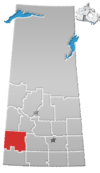Pittville No. 169, Saskatchewan
History
The RM of Pittville No. 169 incorporated as a rural municipality on January 1, 1913.
Geography
Communities and localities
The following urban municipalities are surrounded by the RM.
The following unincorporated communities are located in the RM.
- Localities
Parks and recreation
Demographics
In the 2021 Census of Population conducted by Statistics Canada, the RM of Pittville No. 169 had a population of 201 living in 81 of its 93 total private dwellings, a change of -3.4% from its 2016 population of 208. With a land area of 1,256.42 km (485.11 sq mi), it had a population density of 0.2/km (0.4/sq mi) in 2021.
In the 2016 Census of Population, the RM of Pittville No. 169 recorded a population of 208 living in 82 of its 107 total private dwellings, a 2% change from its 2011 population of 204. With a land area of 1,258.06 km (485.74 sq mi), it had a population density of 0.2/km (0.4/sq mi) in 2016.
Government
The RM of Pittville No. 169 is governed by an elected municipal council and an appointed administrator that meets on the second Tuesday of every month. The reeve of the RM is Larry Sletten while its administrator is Terry Erdelyan. The RM's office is located in Hazlet.
Standing Rock
Standing Rock (50°23′40″N 108°41′09″W / 50.3944°N 108.6857°W) is a large glacial erratic left from the last ice age around 14,000 years ago. It is composed of granite from the Hudson Bay area and is 3.35 m (11.0 ft) high and 9.14 m (30.0 ft) long. It is about 6 kilometres (3.7 mi) west of Hazlet along Highway 332. It was used as a scratching post for bison for centuries, and as a landmark by First Nations and later on by early settlers. It is a recorded petrograph site and is now a historical site.
Transportation
Highways within the RM include:
See also
References
- ^ "Pre-packaged CSV files - CGN, Canada/Province/Territory (cgn_sk_csv_eng.zip)". Government of Canada. July 24, 2019. Retrieved May 23, 2020.
- ^ "Rural Municipality Incorporations (Alphabetical)". Saskatchewan Ministry of Municipal Affairs. Archived from the original on April 21, 2011. Retrieved May 9, 2020.
- ^ "Municipality Details: RM of Pittville No. 169". Government of Saskatchewan. Retrieved May 21, 2020.
- ^ "Population and dwelling counts, for Canada, provinces and territories, and census subdivisions (municipalities), 2016 and 2011 censuses – 100% data (Saskatchewan)". Statistics Canada. February 8, 2017. Retrieved May 1, 2020.
- ^ "Saskatchewan Census Population" (PDF). Saskatchewan Bureau of Statistics. Archived from the original (PDF) on September 24, 2015. Retrieved May 9, 2020.
- ^ "Saskatchewan Census Population". Saskatchewan Bureau of Statistics. Retrieved May 9, 2020.
- ^ "Population and dwelling counts: Canada, provinces and territories, census divisions and census subdivisions (municipalities), Saskatchewan". Statistics Canada. February 9, 2022. Retrieved April 13, 2022.
- ^ Baird, Craig (May 18, 2022). "The History of Hazlet". Canadian History Ehx. Meks. Retrieved January 26, 2023.
- ^ "Standing Rock Natural Phenomenon". Tourism Saskatchewan. Government of Saskatchewan. Retrieved January 26, 2023.
